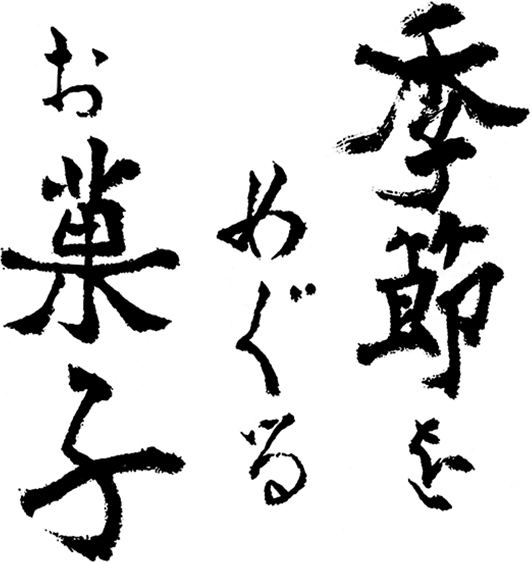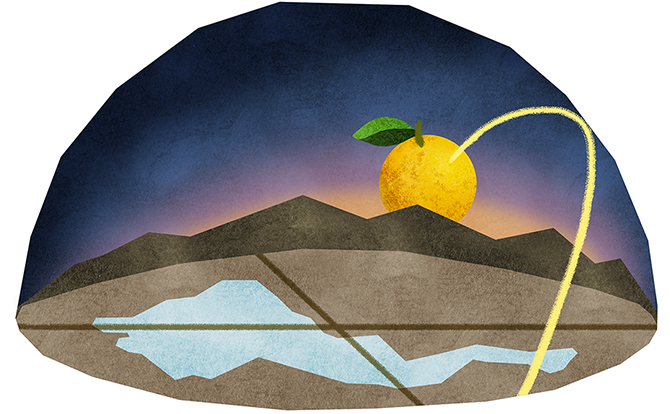 Confectionsfor All Seasons
Confectionsfor All Seasons
Winter / About the confections and their origins
“The winter solstice and the pumpkin”

A prayer entrusted to sparkling yuzu
Every year in the latter half of December, the closer we get to the winter solstice, the more relieved we feel. On the winter solstice, the day is the shortest and the night the longest of the year. From the next day onward, the days begin to lengthen again. It is therefore easy to understand how since olden times the winter solstice gives hope to people who have had to endure the winter cold.
A few days before the winter solstice, yuzu (aromatic citron) are displayed for sale in supermarkets and greengrocers. Even today as many annual recurrences are disappearing, the “yuzu hot bath” on the day of the winter solstice continues to be popular among both the elderly and the young. Hot water is run in the bathtub and yuzu fruits are added. Even just a glance at the floating fruits will make you feel better. Anyone who has a yuzu tree in the garden can enjoy this practice throughout the winter.
But why have “winter solstice and yuzu” become an inseparable match?
First of all, because yuzu, which is a fruit native to warm regions, can also grow in Japan.
Another reason is also thought to be in the yellow, round shape of this fruit which resembles and symbolizes the sun. In the bathhouses of the Edo period there was no electricity like today, and perhaps putting some sparkling yuzu fruits in the bathtubs was a sort of “signal” to announce to everyone the lengthening of the days starting from the following day. It is easy to imagine how people’s faces were radiant with joy by looking at the cheerfully colored fruits.
Pumpkin and azuki red beans
the strongest combination
On the day of the winter solstice,
in addition to the “yuzu hot bath” there are also the customs of eating pumpkin and eating azukigayu (a type of gruel consisting of red beans and rice). In the past, it was challenging to avoid vitamin deficiency during the winter. For this reason, large quantities of winter vegetables such as daikon or napa cabbage were dried in the sun and pickled. Wild mountain plants collected during the spring were also salted and processed as preserved foods.
The pumpkin harvest period runs from early summer until October. Maybe because of their thick and hard skin, pumpkins may be stored for long periods, and no salt is necessary to preserve them. Furthermore, pumpkin is also a fruit rich in vitamin A. Therefore, from a nutritional point of view it made sense to eat pumpkin in winter – when fresh vegetables were not available – to prevent vitamin deficiency.
On the day of the winter solstice there was also the custom of eating azuki red beans. In ancient China it was believed that red-colored beans protect against evil: this is the reason why azukigayu was cooked and ate on the winter solstice. This custom came to Japan directly from the Korean Peninsula. Itoko-ni which is a mix of pumpkin and red beans is also a nutritious dish with a nostalgic flavor, making it suitable for the winter solstice.
Pumpkin is especially useful
on the winter solstice
It is said that another reason why
people ate pumpkin on the day of
the winter solstice was to “gain luck”.
The Japanese word for luck is un,
so all foods ending in the same letter
“n” such as udon or daikon were thought
to bring luck. It sounds like a simple pun, but it shows how much people cared about their health. The houses made of mud, wood and paper were cool in the summer, but not suitable for the winter: this is why people of the past sought in food the strength to overcome the cold season.
Pumpkins are popular in the West for Halloween. It seems that this tradition originated in Ireland, among the Celts who used sweet beets for making lanterns. The Americans replaced sweet beets with pumpkins which were easier to grow, and Halloween became as everyone knows it today. It is very popular in Japan as well, and perhaps modern Japanese consume more pumpkins on Halloween than on the winter solstice.
Above all, eating pumpkin and taking a “yuzu hot bath” on the day of the winter solstice are important habits for the body. We would like them to be practiced forever.